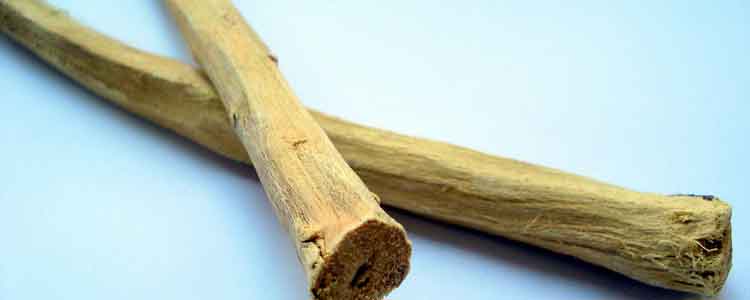
Licorice root has a remarkable list of properly documented uses, and might be among the highest overlooked of all natural treatments. It’s useful for several conditions including asthma, athlete’s foot, baldness, body odor, bursitis, canker sores, chronic exhaustion, melancholy, influenza, coughs, dandruff, emphysema, gout, heartburn, HIV, viral infections, fungal infections, ulcers, liver troubles, Lyme disease, menopause, psoriasis, shingles, sore throat, tendinitis, arthritis, tuberculosis, ulcers, and yeast infections. In this particular article, we will be discussing nine of the more commonly used health benefits of licorice root.
Depression
There is research that shows that the Glycyrrhizic acid that is in licorice root can help with nervousness and depression by encouraging the function of the adrenal glands. Our adrenal glands control stress hormones including cortisol. When one’s stress hormone levels are low it can often be the cause of persistent fatigue, melancholy, anxiety, and having less resistance to infections and allergens. Licorice root also happens to also have the Asparagine amino acid that is needed to preserve equilibrium in the body’s nervous system.
Cardiovascular Disease Studies and High Cholesterol
There has been research that shows that licorice root may control the cholesterol ranges by enhancing the body’s flow of bile. There is also research to indicate that bile acids account for elimination of excessive cholesterol in your body. Also, the antioxidant action of licorice root may enhance capillary health and hinder the growth of arterial plaque.
Menopause
The phytoestrogenic and anti-oxidant action of licorice root is thought to be useful for hormonal problems including exhaustion, mood swings, and hot flashes in women who are going through menopause. Consequently, ingesting just one capsule of licorice root daily can help balance and control a woman’s hormone production if she happens to be going through menopause.
Menstrual and PMS Cramps
This herb has anti-inflammatory, antispasmodic, and a moderate estrogenic action which might assist with PMS symptoms including breast tenderness, menstrual cramps, nausea and bloating, not to mention mood swings. Consuming licorice root as a tea each day starting about three days prior to one’s anticipated time of the month might help to alleviate PMS symptoms.
Skin Problems
Individuals have been making use of this herb as poultices and salves in treating eczema, skin rashes, psoriasis, and itchy and dry skin. A small medical research that was done indicates that the demulcent and anti-inflammatory agents in licorice root gel may decrease the signs of atopic dermatitis (eczema). Just applying a salve made from licorice root onto the area 2 to 3 times daily can help alleviate skin problems.
Gastric and Abdomen Troubles
One benefit of licorice root that is used pretty frequently is that it can be used to deal with digestive abnormalities and many issues with the intestines. The licorice root’s flavonoids can help with discomfort and inflammation of the digestive system. Also, soothing agents in licorice root may quiet and soothe the digestion system, which in turn can help to promote a healthy bowel. Easy treatment would be to have some licorice root tea 2 to 3 times a day.
Herpes and Shingles
Licorice root extract has been utilized in treating herpes simplex, sores, and shingles. Several studies show that the antiviral action of the herb may suppress the return and progression of cold sores due to the herpes virus. Easy treatment for shingles and herpes would be to ingest a capsule of this root extract 2 times a day, and to use a salve made of the same extract on the affected region between four and five times a day.
Weight Reduction
Research demonstrates that individuals had a significant reduction in body fat mass after getting three grams of licorice root extract every day for 2 months. Nevertheless, the eating of licorice root isn’t something that anyone should do for long periods of time. Consequently, although most research indicates routine use of licorice root for two month periods of time, it is preferred to quit the use of the herb for 1 week after every two weeks throughout the two month interval. For weight loss, having a well-balanced diet along with regular exercise might lead to a substantial decrease in body fat.
Salivary Glands
Licorice isn’t a normal or usual herbal treatment for treating problems that include your salivary glands. Even though some treatments use licorice to assist in soothing a sore throat, there currently is no proof that the herb has any impact on saliva production. However, as I said, there have been many herbalists who have recommended the herb be used for this very purpose.
Do You Know the Side Effects of Licorice Root?
The long-term consumption of licorice root might cause hypertension, hypokalemia (low blood potassium levels), cataracts, and the retention of fluid in the body. Consequently, it’s not advised for individuals with heart problems. People that are allergic to Fabaceae (legume, pea, bean, or pulse) could be allergic to licorice root also since the herb is actually a member of the Fabaceae family.
Because of the estrogenic action in the root, it will be something that pregnant ladies will absolutely want to avoid. It’s recommended to talk to your primary care physician to go over any potential problems that licorice root might cause if you’re getting any hormonal medications, or any other medicine or supplements for that matter.
